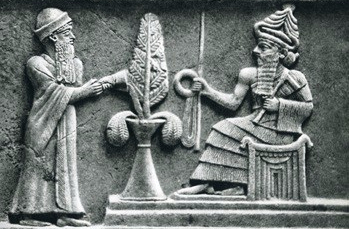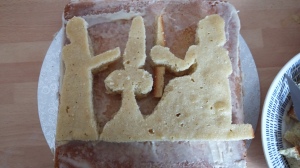This is the detail from the stela of Ur-Namma, the famous image that looks something like the cake I’ve made, and a little more like this:

The stela dates from the Ur III period, at the end of the third millennium BC, and shows the king, Ur-Namma, receiving the ‘rod and coil’, a symbol of power, from the god of his dynasty, while he pours some water on a tree. Incidentally, despite my reproduction, the stela isn’t actually made of a grey stone, but a nice beige one. I’ve seen the black and white copy above so many times that I bought grey fondant without even thinking.
The cake itself is more proof of concept than a truly excellent bake. It’s a bit rough and ready, and it certainly lacks detailing. All of this is a great shame, because I really wanted to say that it was stellar.
My problem was this: how to properly capture Mesopotamian reliefs in cake. Bas reliefs on cakes are normally fondant, pressed into shape in a mold and then laid on top of the cake. There were a few problems with this technique: first, while I am definitely in the market for ancient Mesopotamian molds, I didn’t have one to hand this afternoon. Second, I really dislike the practice of building up huge deposits of fondant on a cake. It’s not because I don’t like eating mounds of pure sugar (its normally best to buy double quantities of fondant when I’m decorating, because I do snack as I go), it just feels like cheating, because at its heart then fondant is just edible modelling clay.

So this is what I went for instead: a sheet of cake, with figures cut from a second sheet and laid on top. Then I built up the 3D features, like the arms and clothing folds with more cake and icing, before laying fondant over it.
It sort of works. What a relief (I’m hilarious).

The other bonus about this cake is that it actually relates to an article I’m writing, which at least references the rod and coil. This is pleasant for me, because my current research focuses on ancient Mesopotamian measuring systems and is heavy in statistics, so it was this or the the Cosine Quantogram analysis. I hear you saying that I couldn’t possibly make that into a cake, and you’d be right. I had to use biscuit to make a version of the Cosine Quantogram analysis results from my last paper. I’ve found the appeal to be limited.



